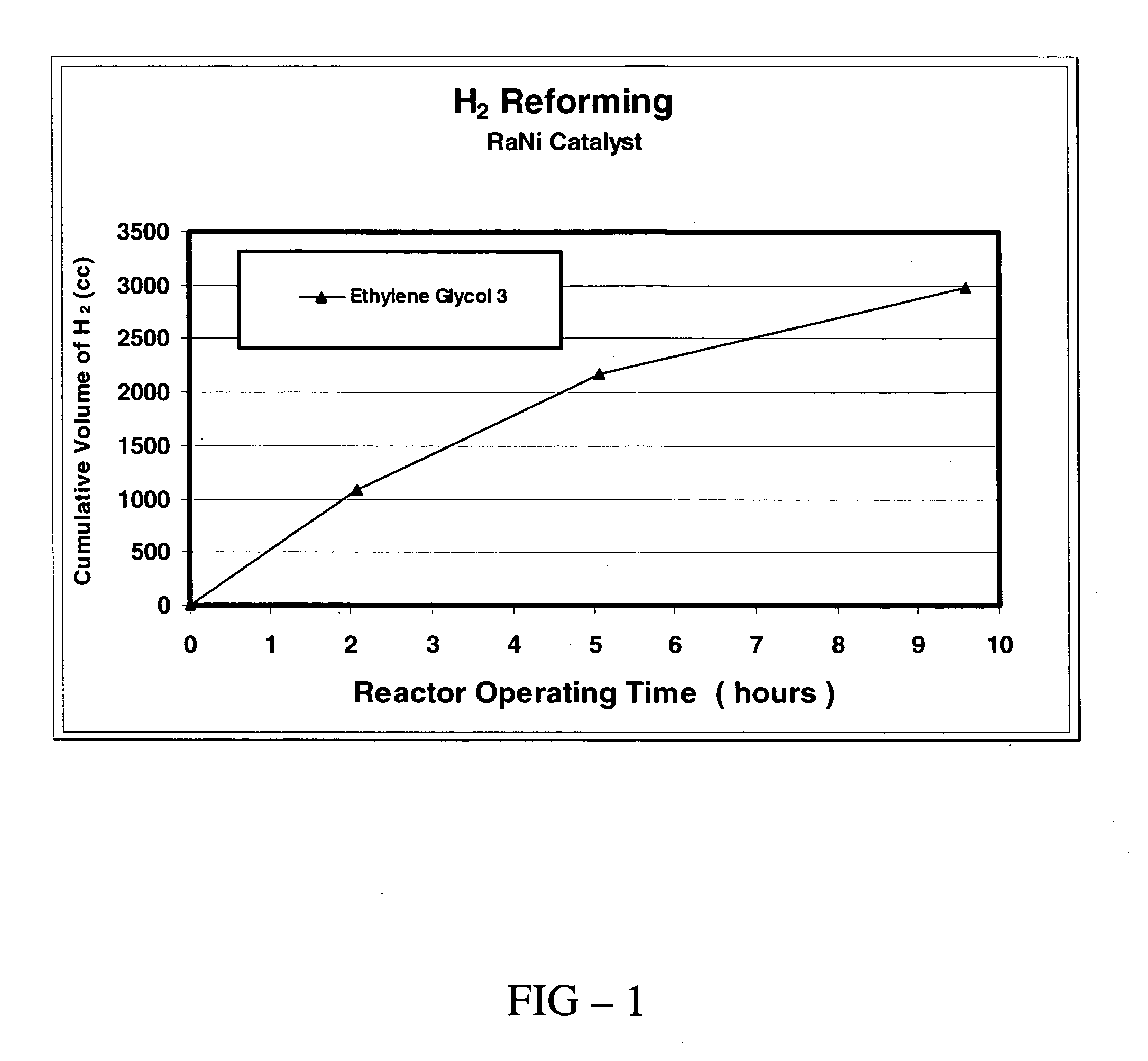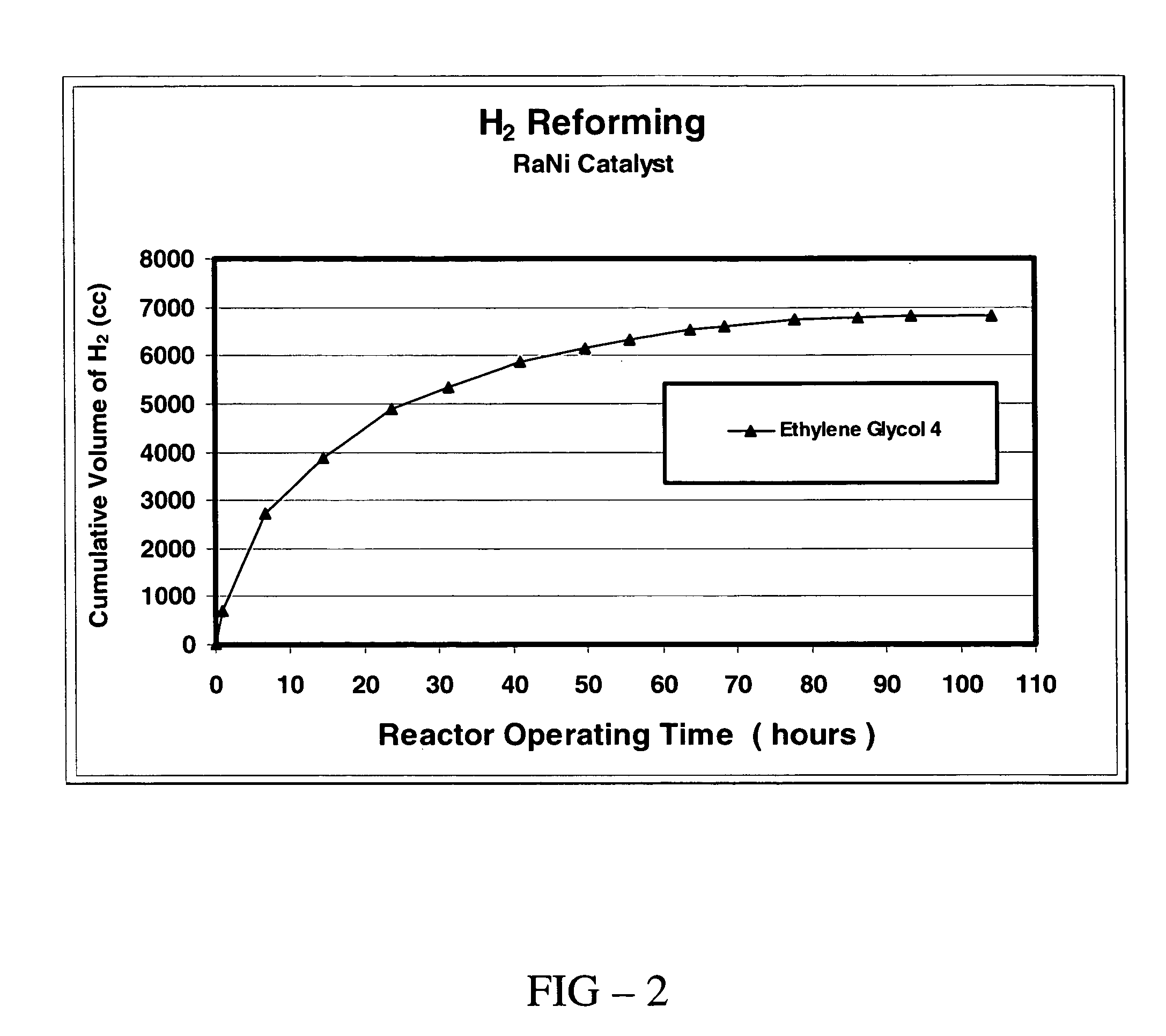Production of hydrogen from non-cyclic organic substances having multiple alcohol functionality
a technology of organic substances and hydrogen gas, which is applied in the direction of lithium compounds, lithium compounds, lithium compounds, etc., can solve the problems of escalating costs, destabilizing economies as well as the likelihood, and increasing fossil fuel consumption, so as to achieve efficient hydrogen production and enable continuous operation of the reaction
- Summary
- Abstract
- Description
- Claims
- Application Information
AI Technical Summary
Benefits of technology
Problems solved by technology
Method used
Image
Examples
example 1
[0045] In this example, the production of hydrogen gas from a reaction of ethylene glycol and sodium hydroxide is demonstrated. A stainless steel reactor having a volume of ˜75 mL and equipped with pressure transducer was used in this experiment. Sodium hydroxide (15 g) and ethylene glycol (26 mL (28.6 gram)) were placed in the reactor. The relative amounts of sodium hydroxide and ethylene glycol are such that sodium hydroxide is the limiting reactant. Water (2 mL) and Raney nickel catalyst (3.5 g) were also added. The reactor was purged by filling the headspace of the reactor with helium and evacuating and repeating for a total of five cycles. The reactor was then filled with helium to a pressure of 1 atm and sealed for the experiment.
[0046] In this experiment, the reactor was heated to several different temperatures and at each temperature, the rate of increase of the pressure was measured. Temperatures between 50° C. and 110° C. were used. The results are summarized below:
Temp...
example 2
[0048] In this example, hydrogen is produced from a reaction of ethylene glycol and sodium hydroxide in a constant temperature reaction. The reactor described in EXAMPLE 1 hereinabove was used in this experiment. Sodium hydroxide (7.5 g), ethylene glycol (14 g), and Raney nickel catalyst (1.75 g) were placed in the reactor. As in EXAMPLE 1, sodium hydroxide was the limiting reactant. The reactor was flushed by filling and evacuating with helium five times as described in EXAMPLE 1 and was charged to a pressure of 1 atm with helium and sealed for the experiment. The reactor was heated to 110° C. and the pressure in the reactor was measured as a function of time. As demonstrated in EXAMPLE 1, hydrogen gas is the primary gas product of the reaction. The rate and amount of hydrogen gas produced by the reaction were measured as a function of the time of reaction. Some of the results are summarized in FIG. 1, where the accumulated volume of hydrogen gas is reported in units of standard cm...
example 3
[0050] In this example, the rate of production of hydrogen gas formed from a reaction of sodium hydroxide with ethylene glycol was measured at 110° C. in an open system reactor and an analysis of the solid phase product was performed. The reactor, reactants (including amounts), and conditions described in EXAMPLE 2 were used in this experiment, with the exception that the reactor was not sealed. Instead, an outlet of the reactor was equipped with a check valve to permit the escape of the gas phase product formed in the reaction. The check valve was set to permit the flow of gas out of the reactor when the pressure in the reactor reached 50 psi. Gas escaping through the check valve was directed by a tube and collected to an inverted graduated cylinder filled with water. Upon heating to 110° C., the rate of hydrogen gas produced (expressed as standard cm3 / hr) and the cumulative volume of hydrogen gas produced were measured as a function of time of reaction and were determined on the b...
PUM
 Login to View More
Login to View More Abstract
Description
Claims
Application Information
 Login to View More
Login to View More - R&D
- Intellectual Property
- Life Sciences
- Materials
- Tech Scout
- Unparalleled Data Quality
- Higher Quality Content
- 60% Fewer Hallucinations
Browse by: Latest US Patents, China's latest patents, Technical Efficacy Thesaurus, Application Domain, Technology Topic, Popular Technical Reports.
© 2025 PatSnap. All rights reserved.Legal|Privacy policy|Modern Slavery Act Transparency Statement|Sitemap|About US| Contact US: help@patsnap.com


